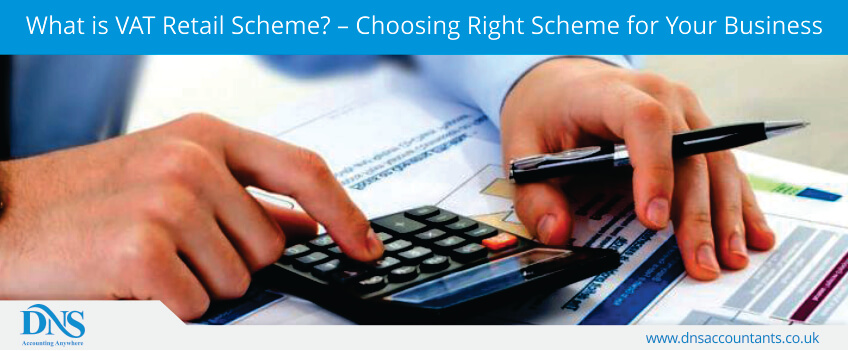What is VAT Retail Scheme?
VAT retail schemes are the schemes designed for businesses to calculate the VAT dues by various methods. By using a VAT retail scheme, you can calculate the value of total taxable sales for a particular period. For ex – under this scheme, Proportion of your sales is taxable at standard, reduced & zero VAT rates. If you are a seller, you must record how much you have to pay in your VAT account. There are two things you have to concentrate on –
- First case – For goods sold inclusive of VAT, you need to deduct the VAT you have to record.
- Second case – For goods sold exclusive of VAT, you need to add the VAT amount.

With the help of this scheme, you can easily calculate the VAT dues. You can calculate it once with each VAT return instead of calculating the VAT amount each and every time you are making the sale. You can join the retail schemes at the beginning of any VAT period and there is no need to tell HMRC regarding it. You can even change it or leave it at the end of any VAT period. You cannot use retail schemes with flat rate scheme.
If you will not use the VAT retail schemes, you have to record the VAT amount of each and every sale in your accounting records.
Note– In the case, if your tax turnover is above £130 million per year, you must leave the scheme immediately and agree to a bespoke retail scheme with HMRC.
Standard Types of VAT Retail Schemes:
There are 3 standard VAT retail schemes by which you can find the VAT dues easily. The same are explained below –
Point of sale scheme- This is one of the most simplest scheme designed for businesses using electronic system which records VAT applied for goods at the time of sale. Under this scheme, you can calculate the VAT on your sale by identifying the VAT rate for the goods sold at the time of sale.
How to calculate VAT using point of scale scheme
- In the first step, you have to add up all the sales you have done for each VAT rate for a particular VAT return period.
- In the second and the last step, for the goods rated at 5%, divide the sales by 21 and for goods rated at 20%, divide the sales by 6.
For example – If you have sold £18000 worth of 20% rated goods and £126 worth of 5% rated goods. How you will calculate the VAT?
Goods rated at 20% = £18000/6 = £3000
Goods rated at 5% = £126/21 = £6
Result – As a result, you will record £3006 (£3000+£6) as VAT dues for the VAT return period.
Apportionment scheme- This is also one of the simplest scheme designed for businesses who are having a tax turnover less than £1 million a year. You can use this scheme only when you buy goods for resale. Under this scheme, you can calculate the total value of your purchases for resale at different VAT rates.
How to calculate VAT using Apportionment scheme
- In the first step, you have to calculate the total value of goods purchased for resale for each VAT rate in a particular VAT period.
- In the second step, you have to divide the total of purchases for each VAT rate by the total value of purchases.
- In the third and the last step, multiply the result by your total sales and divide it by 21 in case of 5% rated goods and divide it by 6 in case of 20% rated goods.
For example – In the VAT period, you buy goods at the following rates –
£20,000 of goods at 20%
£1000 at 5%
£20000 at zero rate
Total purchases - £41,000
Total sales - £35000
For 20% rated goods = £20000/£41000 * £35000/6 = £2845.52
For 5% rated goods = £1000/£41000 * £35000/21 = £40.65
Result – Total VAT for the period is £2886.17
Direct calculation scheme- Direct calculation scheme is designed for the businesses whose are having a tax turnover not exceeding £1 million a year. Under this scheme, you calculate small proportion of sales at one rate and majority of sales at another rate.
There are separate schemes for the businesses that are having the turnover between £1 million to £130 million.
How to calculate VAT using direct calculation scheme
- In the first step, you have to calculate the expected selling prices for minority and majority of goods sold. You can use anyone whichever is easier.
- In the second step, add up the expected sales price (ESP) for a particular VAT period.
- After adding the expected sales price for all VAT rates, divide the total expected sales price by 6 (if your goods are rated at 20%) and deduct the total ESP from total sales (if they are zero rated).
- In the next step, you have to calculate the VAT due on 20% goods by dividing the total value of sale of goods at 20% VAT rate by 6 and to calculate the VAT due on 5% goods; you have to divide the Expected selling price of goods rated at 5% or at a reduced rate by 21.
- In the last step, you have to add the amount of VAT due on the 20% goods and the amount of VAT due on 5% goods to calculate the total VAT amount due.
For example – Total sales are £25000
ESP of zero rated goods = £2500
ESP of 5% goods = £105
= Total sales – ESP of zero rated goods – ESP of 5% goods
= £25000 – £2500 – £105 = £22395
Sales of goods at 20% VAT rate = £22395
To Calculate the VAT due on the 20% goods, divide sales of goods at 20% by 6= £3732.50
To calculate the VAT due on 5% goods, divide ESP of 5% goods i.e. £105 by 21= £5
Result = £3732.50 + £5 = £3737.50
These Schemes are Prohibited under following circumstances
- If you provide services
- If you provide catering services
- If you provide goods made by you
Conclusion
VAT retail schemes are designed for businesses to help them pay VAT easily. Choosing the appropriate scheme depends on the size of your tax turnover. It should be noted that HMRC must be satisfied with the retail scheme you have chosen to give a fair and reasonable result in the amount of VAT paid.
Speak with an expert
Any questions? Schedule a call with one of our experts.
About the author

Sumit Agarwal
Sumit Agarwal (ACMA ACA India), the Managing partner of dns accountants is a highly respected accountant with expertise in helping owner-managed businesses.


_(2).png)






